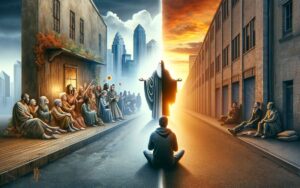Three Examples of Spiritual Beings: Supernatural Entities!
Spiritual beings, also known as supernatural entities or deities, represent a vast array of non-physical entities that are typically associated with religious or other spiritual philosophies.

Key Takeaway
5 Interpretations: Examples of Spiritual Beings
| Interpretation | Description |
|---|---|
| Angels | Spiritual beings often include angels, divine messengers or guardians believed to serve as intermediaries between humans and the divine. |
| Deities and Gods | It encompasses deities and gods from various religious traditions, representing powerful spiritual entities with unique attributes and roles. |
| Spirits and Ancestors | Spiritual beings may also include spirits and ancestors, revered entities in many indigenous and spiritual belief systems, often linked to nature and human lineage. |
| Supernatural Entities | In this context, supernatural entities like jinn, fairies, or mythical creatures can be considered spiritual beings, existing in folklore and spiritual narratives. |
| Spiritual Guides | Spiritual beings can be interpreted as personal spiritual guides, providing insight, protection, and wisdom on one’s life journey. |
Example 1 – Angelic Beings
Angelic beings are spiritual entities that exist beyond the physical realm, providing guidance and protection to humans. These celestial entities are often depicted as messengers of divine light and love.
Angelic beings, also known as angels, occupy a significant place in various religions and mythologies across the world.
Roles And Characteristics Of Angelic Beings:
Messengers of god: Angels are frequently portrayed as messengers delivering important divine revelations and guidance to individuals. Their primary role is to convey messages from the divine realm to humanity.
Protectors and guardians: Angelic beings are also revered as guardians and protectors. They watch over individuals, offering guidance, protection, and support in times of need.
Many people believe that they can call upon angels for assistance and protection in their daily lives.
Mediators and intercessors: Angels are often seen as intermediaries between god or the divine realm and humans. They are believed to intercede on behalf of individuals, bringing their prayers and requests to the heavenly throne.
Spiritual warriors: In certain religions, angels are depicted as spiritual warriors engaged in battles against evil forces. They are seen as powerful beings capable of defeating demonic entities and defending the righteous.
Divine executors: Angels are sometimes portrayed as divine executors, carrying out god’s will on earth. They are assigned specific tasks and responsibilities, ensuring the fulfillment of divine plans.
Famous Examples Of Angelic Beings In Different Religions And Mythologies:
Christianity: In christianity, archangel michael is a prominent figure. Known as the leader of the heavenly hosts, michael is seen as a powerful warrior against evil.
Another well-known angel is gabriel, recognized as the messenger who announced the birth of jesus to mary.
Islam: In islamic tradition, jibril (gabriel) plays a vital role as the angel who revealed the quran to the prophet muhammad. Mika’il (michael) is also mentioned as an angel of mercy and provision.
Hinduism: Hindu mythology includes various celestial beings known as devas, which can be understood as angelic beings. They are considered divine and serve different deities in the hindu pantheon.
Judaism: In judaism, angels play a significant role as messengers and protectors. Notable examples include archangel gabriel and archangel raphael, associated with healing and miracles.
Zoroastrianism: Zoroastrianism acknowledges the presence of celestial beings called “amesha spentas.” These angelic beings embody different aspects of divine attributes, such as wisdom, justice, and immortality.
Norse mythology: Norse mythology features valkyries, female angelic-like beings who choose the warriors deemed worthy of entering the afterlife realm of valhalla.
These are just a few examples of the diverse roles and representations of angelic beings found in various religious and mythological traditions.
Example 2 – Demonic Beings
Demonic beings are just one example of the various spiritual entities that exist. These dark entities are often associated with malevolence and are believed to possess supernatural powers.
Traits And Characteristics Of Demonic Beings:
- Demonic beings are often depicted as malevolent creatures in various cultural and religious beliefs.
- They are associated with evil, darkness, and temptation.
- These beings are believed to possess supernatural powers and are capable of causing harm to humans.
- They are often described as having a twisted and grotesque appearance, with sharp claws, horns, and fangs.
- Demonic beings are known for their cunning and deceptive nature, manipulating humans to carry out their nefarious plans.
- They thrive on fear, feeding off negative energy and creating chaos wherever they go.
Notable Examples Of Demonic Beings In Various Cultural And Religious Beliefs:
- In christian mythology, satan is considered the embodiment of evil and the ruler of all demons. He is often portrayed as a fallen angel who rebelled against god.
- Asmodai, also known as asmodeus, is a prominent demon in jewish folklore. He is associated with lust, possession, and destruction.
- In hinduism, ravana is a demon king known for his ten heads and immense power. He is a symbol of arrogance and represents the battle between good and evil.
- In japanese mythology, the tengu is a supernatural creature with both human and bird-like features. They are often portrayed as mischievous and malevolent entities.
- Pazuzu, a demon of the ancient mesopotamian culture, is depicted as a fearsome creature with a human body, lion-like face, and wings. He is associated with storms and pestilence.
These are just a few examples of the diverse representations of demonic beings found in different cultural and religious beliefs. Each carries its own unique characteristics and symbolism, adding depth to the world of spiritual beings.
Example 3 – Nature Spirits
Nature spirits are spiritual beings that are deeply connected to the natural world. They are examples of ethereal entities that inhabit and protect forests, rivers, and mountains, embodying the forces of nature with their unique energy and wisdom.
Different Kinds Of Nature Spirits And Their Associations With Natural Elements
- Water nymphs: These ethereal beings are associated with water bodies such as oceans, rivers, and lakes. They are often depicted as beautiful maidens who frolic near the water’s edge and bring healing and purification.
- Tree elves: These mischievous spirits reside in trees and forests, playing a vital role in maintaining the balance of nature. They are guardians of the plants and animals within their domains.
- Earth gnomes: Known for their close connection to the earth, these underground dwellers are said to possess great strength and wisdom. They are often associated with caves, mountains, and minerals.
- Air sylphs: Representing the element of air, sylphs are ethereal beings that inhabit the skies. They are commonly depicted as graceful, winged creatures who bring inspiration and creativity.
- Fire salamanders: These mystical creatures are associated with the element of fire. Despite their name, they are not actual salamanders but rather beings of pure energy that dwell within flames.
Prominent Examples Of Nature Spirits In Folklore And Spiritual Traditions
- Pukwudgies: In native american folklore, pukwudgies are small, mischievous spirits believed to inhabit the forests of north america. They are known for their shape-shifting abilities and have both helpful and playful natures.
- Nymphs: Originating from greek mythology, nymphs are female nature spirits associated with various natural elements. They are often depicted as beautiful young maidens who embody the essence of their respective surroundings.
- Dwarfs: Dwarfs, found in various mythologies around the world, are small, stout beings that dwell underground. They are skilled craftsmen and miners who guard hidden treasures.
- Djinn: Originating from arabian mythology, djinn are supernatural beings made of smokeless fire. They possess great power and can grant wishes to mortals. However, they can also be mischievous and vengeful if not treated with respect.
- Elves: Known for their association with forests, elves are mystical beings found in folklore across many cultures. They are often depicted as beautiful, long-living creatures with magical abilities.
These nature spirits, found in various folklore and spiritual traditions, represent our connection to the natural world.
Their unique qualities and associations with different elements make them fascinating beings to explore in our quest for spiritual enlightenment and understanding.
Conclusion
We have explored various examples of spiritual beings and their significance in different cultures and religions.
From angels and demons to gods and goddesses, these spiritual beings have a profound impact on human beliefs and experiences.
Through our exploration, we have seen that spiritual beings serve as intermediaries between the divine realms and human existence.
They offer guidance, protection, and sometimes even challenge individuals on their spiritual journeys.
Understanding these diverse examples of spiritual beings can provide us with a deeper appreciation for the multifaceted nature of human spirituality.






